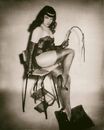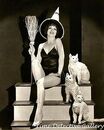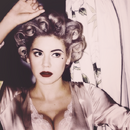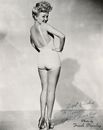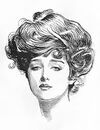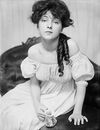CW: This article contains descriptions of and NSFW photography
Pin-up modeling originated in the 1890s with the Gibson Girl drawings of Charles Dana Gibson, although the term ‘Pin-Up’ wasn’t used until 1941. The style is mainly expressed by women, although men are rarely involved. Female models are also called Cheesecake models, while men are called Beefcake models.
Pin-up models would be photographed in anything from scantily clad clothing to being in the nude. In 1952 actress Marilyn Monroe was asked about her infamous 1949 pin-up photo (included in gallery) and said "It’s not quite true I had nothing on: I had the radio on." Monroe, in more modern times, has become known as a sexual and feminist icon, and the pin-up modeling style was taken as a modern aesthetic which displays themes of sexuality, woman's empowerment, lust, and beauty.
History[]
Adverts for burlesque shows in the 1800s were the beginning of pin-ups, even though the term wasn't developed until the 1940s. The Gibson Girl style of the late 1800s is also a part of the pin-up aesthetic's history but in a different aspect.
Gibson Girls was a style based on Charles Dana Gibson’s art. It’s characterized by Edwardian corsets and Bouffant hair on women who were always keeping up with fashion trends. Unlike burlesque performers, Gibson Girls wouldn't show skin or perform for crowds. They wouldn't cover up in layers of shapeless gowns, preferring to wear close-fitting thin layered dresses to accentuate their curves. They were seen as the epitome of the modern woman: not afraid to go into the workforce, owning their sexuality, and displaying themselves confidently. This was controversial at the time and the public branded the behavior “slutty," a word which has no real meaning in and of itself but was historically disparaging.
An often overlooked part of pin-up history is the Black history facet. Many famous cheesecake models were white, but bombshells like Dorothy Dandridge and Josephine Baker remastered their corners of the pin-up industry in the 1920s and 30s.
Another artist that greatly contributed to pin-up’s devolvement was Alberto Vargas in the last 1930s. Similar to Gibson, his drawings were called Vargas Girls. They were much more provocative, often appearing completely nude. Although they were more sexual, they were more admired for their natural beauty than their sex appeal.
War Times[]
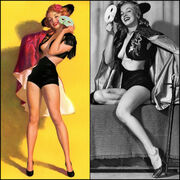
19-year-old Marilyn Monroe's modeling for painter Earl Moran
When the United States entered World War Two in late 1941, pin-ups became popular to boost drafted troop morale. Models were seen as more sexual and kinky, often dressing up in military-inspired costumes, and were supposed to incite lust in young men.
From here, pin-up modeling went down two routes; innocent, playful, yet suggestive; and naughty and BDSM-like. The majority of pin-up modeling in the 1940s were the innocent/playful type (this is often called Gamine). Pin-up wasn't just photography, as many artists also painted pin-up models, like Earl Moran.
Zoë Mozert was also a huge part of the early pin-up community. She was a painter who often used herself as a model, equipping cameras and mirrors. She signed an exclusive calendar contract with Brown and Bigelow the same year that the U.S. joined WWII, 1941.
Most famous war-time pin-up models were women like Marilyn Monroe, Rita Hayworth, Betty Grable, Cleo Moore, Jayne Mansfield, etc.
Playboy Era[]
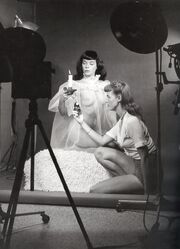
Bettie Page (left) and Bunny Yeager (right)
The magazine Playboy was a quintessential part of pin-up culture. It was founded by Hugh Hefner in 1953, and its first issue included the 1949 photo of Marilyn Monroe by Tom Kelley. The magazine caused the main uprise in kinky BDSM-style pin-ups rather than the pin-ups simply being shown to young soldiers. This era coincided with the rise of Bettie Page's fame. Page was one of Playboy's first playmates, which gave way to her fame. Hefner described Page as "a combination of wholesome innocence and fetish-oriented poses that is at once retro and very modern.".
As her fame grew, so did her independence and public sexuality. In the 50s she started modeling and acting in fetish films and photos. She appeared in short "specialty" films where she acted out fetishes with only other women (important to note; this wasn't considered pornography necessarily, as no one in these films were ever naked). Because of her work in these films, she became known as the "Queen of Bondage" and "The Girl with the Perfect Figure". She often collaborated with model and photographer Bunny Yeager. Yeager was also a model, but never did pin-up or nudity, unlike Page.
Page became the first famous bondage model. Her short films had themes of abduction, domination, spanking, leather costumes, slave-training, etc. Her acting range was anywhere from Dominatrix to helpless victim. Her work in the BDSM industry introduced conservative 1950s America to sexual exploration, which later inspired singers like Madonna, Britney Spears, and Lady Gaga.
Modern Pin-up[]
Pin-up modeling in the modern sense is a fashion style that involves clothes that are very skimpy and showing, and remains a modeling style to this day, with many celebrities posing nude at some point. The current aesthetic of pin-up is still lustful and is nostalgic to those who have seen retro trends, but has also inspired many other aesthetics that can be innocent and sweet but with a sexually aggressive edge.
Visuals[]
- Black and white photography
- Creams, red, pastels, black
- Makeup and hair; Full, shaped brows; vibrant red matte lipstick in a "hunters bow" shape; water waves hair style; victory rolls; and Bettie bangs
- Lingere
- Female nudity
- Delicate, soft looking women
- Silhouette figures
- Cheetah print
- Tuelle
- Satin
- Tattoos on modern day models
Models[]
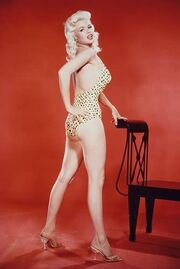
Jayne Mansfield
Golden Age of Hollywood (1900 - 1960s)[]
Cheesecake Models[]
- Bettie Page
- Marilyn Monroe
- Josephine Baker
- Betty Grable
- Elvira
- Kim Novak
- Ava Gardner
- Sophia Loren
- Clara Bow
- Carole Lombard
- Brigitte Bardot
- Lauren Bacall
- Diana Dors
- Hedy Lamarr
- Dorothy Dandridge
- Rita Hayworth
- Jayne Mansfield
- Gina Lollobrigida
- Cleo Moore
- Veronica Lake
- Sandra Dee
- Jean Harlow
- Jane Russell
- Eartha Kitt
- Betty Boop
Beefcake Models[]
- James Dean
- Jim Morrison
- Rudolph Valentino
- Ramón Novarro
- Johnny Weissmuller
- Buster Crabbe
- Tony Curtis
- Rock Hudson
- Tab Hunter
- Jeff Chandler
- Robert Conrad
- Robert Wagner
- Elvis Presley
Modern Day (1970s+)[]
Cheesecake Models[]
- Sabina Kelley
- Gogo Blackwater
- Cherokee Jackson (AKA thecherrydollface)
- Claire Sinclair
- Sarah Marie Summer
- Dita Von Teese
- Angelique Noire
- Natasha Noir
- Anna Nicole Smith
- Jessica Rabbit
Beefcake Models[]
- Burt Reynolds
- Nick Kamen
Pulp Magazines[]
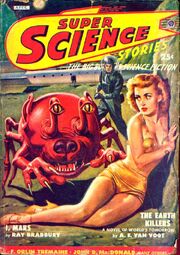
Pulp Magazine "Super Science"
Pulp Magazines were cheap magazines from the late 1800s to the mid 1900 hundreds. They were also called "pulp fiction" "the pulps", "slicks", and "glossies". They were about 130 pages, and contained typical, mediocre fiction. Even though many renowned and respected authors worked on them, they were looked down on. Pulp magazines often featured pin-up art, called "pulp art".
These stories had a variety of genres but almost always had some sort of sexual and exploitative aspect. Some of these genres were:
- Adventure
- Spicy (soft porn)
- War
- Detective/crime
- Fantasy
- Horror
- Romance
- Science fiction
- Westerns
- Superhero
Origins[]
The first pulp magazine was Argosy, from 1896, although it featured no art. In the beginning, they cost a nickel, which gave them the name "dime novels", although this price would later change. Street and Smith was the next big magazine in the pulp industry at the time, and did include art. Its fame skyrocketed when their book Ayesha was made into a series in 1905. It also made the Lost World sub-genre more popular, influencing other pulp writers like Robert E. Howard, Talbot Mundy, Edgar Rice Burroughs, and many others. It's popularity raised the price to ¢15. This encouraged Street and Smith to begin adding other genres to their magazine like detective, romance, spicy, mix of multiple types (like spicy detective), etc.
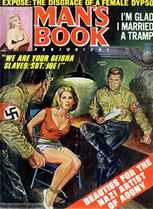
1967 MAN'S BOOK featuring pin-up model Eva Lynd
By the 1930s, the most popular pulp magazines were Adventure, Argosy, Short Stories, and Blue Book. These inexpensive magazines became one the major sources of entertainment during the great depression. However, during WWII, paper became more expensive, since most resources were used for the war effort, and pulps became more costly. This made the original appeal of glossies disappear, which began its decline. To combat the paper shortages, many company's switched to digest sizes, which made them more compact and small. The popularity of comics, televisions, and paperbacks also negatively impacted their deterioration. By the 1950s, the "Men's Adventure" magazine's took pulps place. These magazines also featured pin-up art.
Men's Adventure[]
Men's adventure magazines took pulp magazines place in the late 1940s up until the 1970s. They were also called "armpit slicks", "the sweats", or "men's sweat magazines". As the name suggest, these magazines were directed towards a male audience with stories of wartime adventures and enticing travels featuring pin-up girls. Pulp magazines like Argosy and Adventure eventually switched to sweat magazines. Other magazines popped up in the Men's Adventure genre like "Swank", "World of Men", "Cavalier", "Man's Epic", and "Stag". Because of World War Two, Nazi's and Communist's often took the villain role.
They almost always featured the trope of damsels in distress. The introduction of sexually-deviant behavior was likely influenced by Bettie Page's S&M films and photography. Books featuring women in peril almost always shows women exploited and in bondage. Occasionally though, it showed women in power and dominance. These dominatrix characters would dominate men as well as women, or even both.
Artists and Photographers[]
Artists[]
- Earl Moran
- Alberto Vargas
- Olivia De Berarinis
- Luma Rouge
- Fiona Stephenson
- Zoë Mozert
- Joyce Ballentyne
- Irene Patten
- Laurette Patten
- Ruth Deckard
- Arnold Armitage
- Rolf Armstrong
- Aslan
- McClelland Barclay
- Vaughan Bass
- Edwin Georgi
- Paul Rader
- Milo Manara
Photographers[]
- Bunny Yeager
- Tom Kelley
- Bruno Bernard
- John Willie
- Andre De Dienes
- Peter Gowland
- Frank Powolny
Media[]
Movies and TV shows[]
- The Notorious Bettie Page (2005)
- The Seven Year Itch (1955)
- PinUp Girl (1944)
- Gilda (1946)
- Gentlemen Prefer Blondes (1953)
- Hollywoodland (2006)
- Calendar Girl Murders (1984)
- Pin Up! (2015)
Music[]
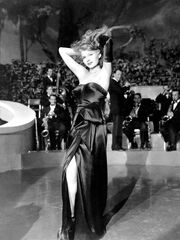
Put the Blame on Mame
- Diamonds Are a Girl's Best Friend (Marilyn Monroe)
- Put the Blame on Mame (Rita Hayworth)
- Her (Poppy)
- Goodbye Norma Jeane/Candle In The wind (Elton John)
- I Wanna Be Loved By You (Marilyn Monroe)
- Valley of the Dolls (Marina)
- Amada Mio (Rita Hayworth/Anita Kert Ellis)
- Soda Pop (Britney Spears)
- Material Girl (Madonna)
- Honeymoon Avenue (Ariana Grande)
- Tattooed Heart (Ariana Grande)
- Lucky (Britney Spears)
- Primadonna (Marina)
- Oops! ...I Did It Again (Britney Spears)
- Hips Don't Lie (Shakira)
- Monster (Lady Gaga)
- Aura (Lady Gaga)
- Touch My Body (Ayesha Erotica)
Books[]
- My story (Marilyn Monroe)
- Change-Makers: The pin-up book of pioneers, troublemakers and radicals (Matilda Dixon-Smith)
- Veronica (Veronica Lake)
- Tab Hunter Confidential: The Making of a Movie Star (Tab Hunter)
- Pin-Up Grrrks; Feminism, Sexuality, Popular Culture (Maria Elena Buszek)
- American Prince: A memoir (Tony Curtis)
- Everything and Nothing: The Dorothy Dandridge Tragedy (Dorothy Dandridge)
- The Great American Pin-up (Charles Martignette and Louis K. Meisel)
- Gentlemen Prefer Blondes (Anita Loos)
- Ayesha (H. Rider Haggard)
Magazines[]
- Blue Book
- Short Stories
- Ellery Queen's Mystery Magazine
- Argosy
- Pall Mall Magazine
- The Story-Teller
- Adventure
Associated Brands[]
- Playboy
- Pinup Girl Clothing
- Atomic Boutique
- Bettie Page Store

